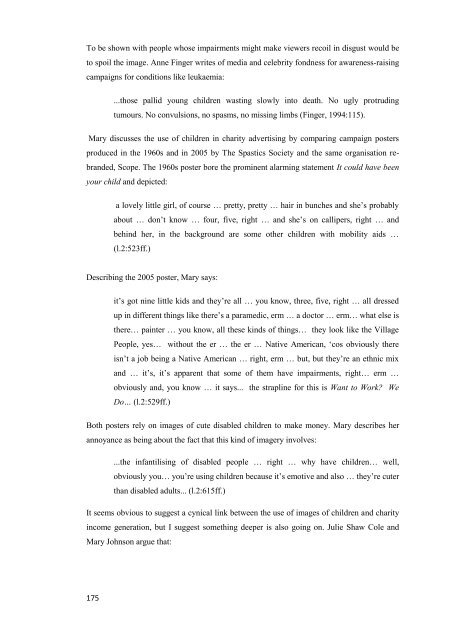A thesis submitted in partial fulfilment of - Etheses - Queen Margaret ...
A thesis submitted in partial fulfilment of - Etheses - Queen Margaret ...
A thesis submitted in partial fulfilment of - Etheses - Queen Margaret ...
Create successful ePaper yourself
Turn your PDF publications into a flip-book with our unique Google optimized e-Paper software.
To be shown with people whose impairments might make viewers recoil <strong>in</strong> disgust would be<br />
to spoil the image. Anne F<strong>in</strong>ger writes <strong>of</strong> media and celebrity fondness for awareness-rais<strong>in</strong>g<br />
campaigns for conditions like leukaemia:<br />
175<br />
...those pallid young children wast<strong>in</strong>g slowly <strong>in</strong>to death. No ugly protrud<strong>in</strong>g<br />
tumours. No convulsions, no spasms, no miss<strong>in</strong>g limbs (F<strong>in</strong>ger, 1994:115).<br />
Mary discusses the use <strong>of</strong> children <strong>in</strong> charity advertis<strong>in</strong>g by compar<strong>in</strong>g campaign posters<br />
produced <strong>in</strong> the 1960s and <strong>in</strong> 2005 by The Spastics Society and the same organisation re-<br />
branded, Scope. The 1960s poster bore the prom<strong>in</strong>ent alarm<strong>in</strong>g statement It could have been<br />
your child and depicted:<br />
a lovely little girl, <strong>of</strong> course … pretty, pretty … hair <strong>in</strong> bunches and she‟s probably<br />
about … don‟t know … four, five, right … and she‟s on callipers, right … and<br />
beh<strong>in</strong>d her, <strong>in</strong> the background are some other children with mobility aids …<br />
(l.2:523ff.)<br />
Describ<strong>in</strong>g the 2005 poster, Mary says:<br />
it‟s got n<strong>in</strong>e little kids and they‟re all … you know, three, five, right … all dressed<br />
up <strong>in</strong> different th<strong>in</strong>gs like there‟s a paramedic, erm … a doctor … erm… what else is<br />
there… pa<strong>in</strong>ter … you know, all these k<strong>in</strong>ds <strong>of</strong> th<strong>in</strong>gs… they look like the Village<br />
People, yes… without the er … the er … Native American, „cos obviously there<br />
isn‟t a job be<strong>in</strong>g a Native American … right, erm … but, but they‟re an ethnic mix<br />
and … it‟s, it‟s apparent that some <strong>of</strong> them have impairments, right… erm …<br />
obviously and, you know … it says... the strapl<strong>in</strong>e for this is Want to Work? We<br />
Do… (l.2:529ff.)<br />
Both posters rely on images <strong>of</strong> cute disabled children to make money. Mary describes her<br />
annoyance as be<strong>in</strong>g about the fact that this k<strong>in</strong>d <strong>of</strong> imagery <strong>in</strong>volves:<br />
...the <strong>in</strong>fantilis<strong>in</strong>g <strong>of</strong> disabled people … right … why have children… well,<br />
obviously you… you‟re us<strong>in</strong>g children because it‟s emotive and also … they‟re cuter<br />
than disabled adults... (l.2:615ff.)<br />
It seems obvious to suggest a cynical l<strong>in</strong>k between the use <strong>of</strong> images <strong>of</strong> children and charity<br />
<strong>in</strong>come generation, but I suggest someth<strong>in</strong>g deeper is also go<strong>in</strong>g on. Julie Shaw Cole and<br />
Mary Johnson argue that:




